Gas heating in a private house: general principles of the device and many useful tips
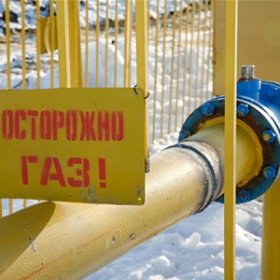
Stoves are now not so often used as a home heating system. They give up their positions not only in small cities and towns, but even in summer cooperatives. The stove is becoming more of an attribute, a beautiful piece of furniture. In its place came the gas heating of a private house. The purchase of all equipment today does not require sky-high amounts, such as, for example, 15-20 years ago. In addition to gas, heating with solid fuel, waste, gas cylinders and electricity is becoming popular. Each of these systems has a right to exist. One owner needs complete autonomy, another needs a minimum heating bill, a third needs comfort, and someone else needs environmental friendliness.
Content
Bottled gas heating
Main gas for many residents of country houses remains a dream. A gas storage tank is a very expensive pleasure, just like a pellet boiler. It is not always possible to connect a heating system with electricity either. A few years ago it was profitable to heat the house with diesel fuel, but its prices rose significantly and the savings came to naught. An economical waste boiler remains, but you will not leave it unattended. Here are almost all options for heating systems. The furnace can not be taken into account; it cannot be a priori autonomous. Geothermal heating, heat pump, solar panels - these are expensive and difficult to maintain and install systems.
By the method of exclusion, we come to heating with gas cylinders. Such a system is autonomous to some extent: it all depends on the time of the absence of the owners of the house. In principle, the issue can be resolved by connecting several cylinders. But in winter you can leave her unattended for a week or two.
We heat the house with convectors
The heating system can be based not only on boilers, but also on convectors. Most often they are selected depending on the area of the premises at the rate of 1.0 kW of power per 10 m2. True, if you do not heat the house in winter, but from early spring to late autumn, you can do with a lower value. But, if the house is intended for permanent residence, it is better to calculate the heat loss for each room. Then even in severe frost the system will cope with the work.
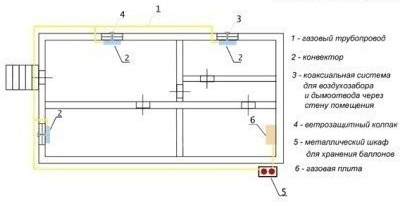
A metal storage cabinet for cylinders can be installed in the house, but for security reasons it is better to place it on the outer wall
The convector is installed stationary on the wall of a room or other room. In addition to it, fittings for wiring, a reducer, at least two cylinders with a valve for propane and a metal cabinet for their storage will be needed. For storage of gas, capacities of five to fifty liters are produced.The latter, of course, are most suitable for heating a house. The gearbox must be of high quality and operate stably in the operating pressure range at an external temperature of minus twenty-five degrees Celsius.
Information on the principle of operation and arrangement of gas convectors can be found in our material:https://aquatech.tomathouse.com/en/otoplenie/radiatory/kak-vybrat-gazovyj-obogrevatel-dlya-dachi.html.
A cupboard with balloons can be placed on the outside wall of the house, in the kitchen or on the terrace. The first option is preferable both from the point of view of safety, and for the sake of saving space. From the convector to the cylinder, the wiring is carried out by seamlessly curved steel pipes (½ "or ¾"). They should not have threaded joints or angles. In places of branching, pipe fragments are welded.
The cabinet with cylinders must not be installed in rooms with a subfloor or cavities. Propane is heavier than air and will accumulate in the event of a leak. An explosive concentration may be reached within a few days.
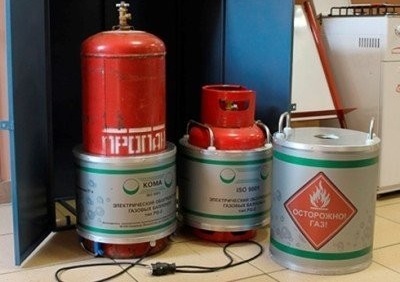
A cabinet for storing gas cylinders is a mandatory safety requirement. It is better to install it either at the outer wall of the house, or in a warm boiler room with a concrete floor and thick walls
Experts advise placing cylinders in special rooms - boiler rooms. They should have a concrete floor and thick walls. This is to ensure the safety of the residents. And so that the efficiency of use of this fuel was higher, the temperature in the boiler room should be +20 C.
Which boiler is needed and how much does one cylinder last?
Most boilers can operate on both main and liquefied gas. Depending on the type of fuel, one of the two burners that are included in the kit is installed.
When choosing a boiler, it is better to give preference to those with a lower lower threshold for working gas pressure. This will maximize the use of the cylinder. With the right settings, the heating system consumes one for three to four days.
To heat a heated house with an area of 130 m2 and hot water per week consumes 3-4 cylinders. At the same time, the temperature in the house is around the clock +21 ... + 23 ° С, and on the street from minus 18 ° С to minus 23 ° С.
How to reduce gas consumption?
Fuel consumption can be reduced in the same ways as in any other:
- set automation;
- install propane sensors in a room with cylinders, which will allow timely detection of a leak;
- to insulate the house, if it was not done;
- observe the temperature regime in the room with cylinders, as at minus 25 ° С and below the system may have;
- purchase gas from trusted suppliers, because low-quality fuel at low temperatures simply will not ignite.
Subject to the above measures gas consumption reduced by 20-40%, therefore, the cylinder is enough for four days.
Programmer settings example: in a frame insulated house (135 m2) from 23:00 to 6:00 the temperature is maintained at +14 ° C, from 6:00 to 9:00 it increases to +21 ° C, from 9:00 to 16:00 until everything at work and at school drops to +12, and from 16:00 to 23:00 in the house +23 ° С. On weekends from 23:00 to 8:00 - +14 ° С, from 8:00 to 23:00 again +23 ° С. With these settings, it takes about 6-7 cylinders per month. However, holidays and holidays significantly increase consumption in December-January. On average, for the heating season per month (taking into account hot water supply and a gas stove), 9-11 cylinders are needed.

At the same time, two or more cylinders can be connected to the system, however, keep in mind that the pressure in the cylinders is high. Safety comes first
One way to reduce gas consumption is to install Gas Saver. But is a housekeeper so good? Useful information about its device and principle of operation, as well as reviews you will find in our article:https://aquatech.tomathouse.com/en/gazosnabzhenie/gas-saver-razvod-ili-pravda.html.
We heat a country house with natural gas
Natural gas, among other fuels, is a leader. With a modern efficient boiler, a well-insulated house is heated with minimal cost. Of course, there are cheaper sources of energy, but they are not autonomous: solid fuel needs to be constantly laid, electricity can be turned off, gas in cylinders completely ends up periodically.
Features of the use of gas boilers
When choosing a boiler, you need to proceed from the area of the house and the hydraulic calculation.A wall-mounted convection boiler copes with heating a three-hundred-meter house. You can install condensing equipment. It is suitable for houses up to 400 m2. Such boilers use not only fuel energy, but also steam condensate. Their energy efficiency is much higher. If suddenly the equipment’s performance is not enough, you can use the “cascade” function.
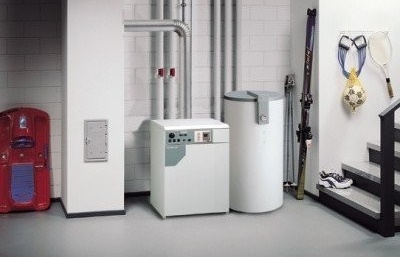
A few years ago, the cost of a boiler for heating was very high. But now that this equipment has become quite affordable, it’s more profitable to use natural gas to heat a house and organize hot water supply than any other type of fuel
Hot water can be provided by an electric boiler, but if the heating of a private house is based on the use of natural gas, it is more economical to use it for heating water. To do this, you need to purchase either a dual-circuit gas boiler, or supplement the existing tank. You can choose the volume based on domestic needs. Boiler columns maintain a supply of water at the right temperature. The flowing gas boiler heats the water at the time of supply. After opening the tap, cold water will first come down, and only then will hot water go.
The circuit diagram of such a system
The scheme of the gas heating system of a private house includes a heat source, from which the coolant first diverges through the collector through pipes to radiators, and then, cooling down, returns to the boiler. The fluid is under pressure. The circulation in this case is forced. Additionally, air vents, stopcocks, flow and temperature sensors, thermal heads can be installed. Automate helps regulate the temperature.
The system can also be designed for natural circulation, then an expansion tank is included in the circuit at the highest point of the house. Here you can save on temperature sensors, air vents and expensive pumps.
The wiring of the heating can be radial or tee. The first is more expensive due to the larger footage of the pipeline, but more efficient and more mobile, it is easier to repair during the heating season. The second is cheaper due to the smaller number of pipes, but it does not provide such wide opportunities for regulating the temperature in individual rooms, as radiation distribution.
The number of radiators in the system is determined based on thermal and hydraulic calculations. This is the most correct option both from a technical and economic point of view.
Do not rely on the advice of unskilled sellers and people from: number of sections no need to choose based on the area of the room.
Natural gas heating equipment needs minimal service, which, incidentally, can be done on its own. Fuel burns up without forming a solid residue. In order not to install a chimney, you can purchase a boiler with a closed combustion system.
If by the end of construction of the house there is no gas main, you can purchase a boiler using two types of fuel. After gasification, the transition to economical and efficient natural gas will not require significant material costs. The maximum will need to call a specialist from a service company.
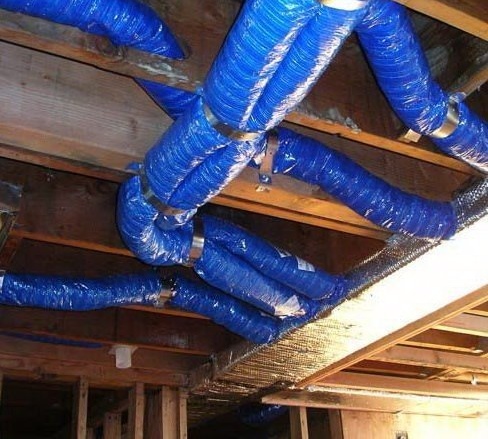
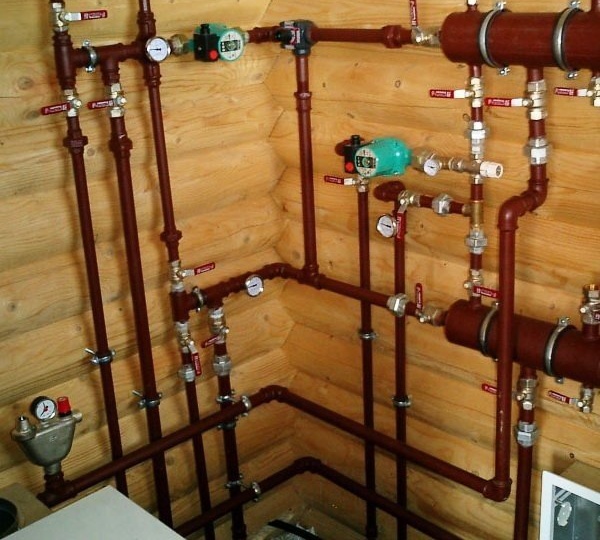
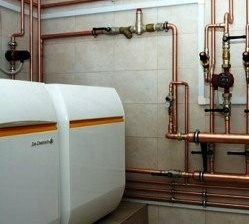
1 comment